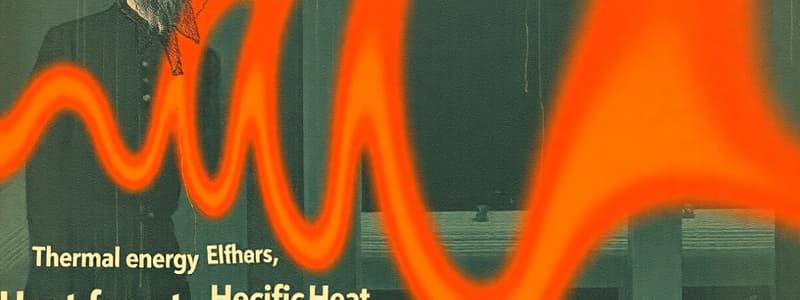Podcast
Questions and Answers
ما هو العامل الذي يتحدد بناءً عليه مقدار الحرارة النوعية للمادة؟
ما هو العامل الذي يتحدد بناءً عليه مقدار الحرارة النوعية للمادة؟
- درجة حرارة الجسم
- حركة الجزيئات
- حجم الجسم
- نوع مادة الجسم (correct)
ما هو التعبير الرياضي الصحيح لحساب الحرارة؟
ما هو التعبير الرياضي الصحيح لحساب الحرارة؟
- Q = S (T_2 - T_1)
- Q = S.m (T_1 - T_2)
- Q = m (T_2 + T_1)
- Q = m (T_2 - T_1) (correct)
ما الذي يؤثر على قيمة الحرارة النوعية للمادة؟
ما الذي يؤثر على قيمة الحرارة النوعية للمادة؟
- الرطوبة
- نوع الجسم (correct)
- الضغط
- اللون
ما هو المعادلة الصحيحة التي تعبر عن علاقة الحرارة بالكتلة وفرق درجات الحرارة؟
ما هو المعادلة الصحيحة التي تعبر عن علاقة الحرارة بالكتلة وفرق درجات الحرارة؟
الحرارة النوعية للمادة تعتمد على أي من المعطيات التالية؟
الحرارة النوعية للمادة تعتمد على أي من المعطيات التالية؟
ما هو المعادلة المستخدمة لحساب الحرارة النوعية للغاز تحت حجم ثابت؟
ما هو المعادلة المستخدمة لحساب الحرارة النوعية للغاز تحت حجم ثابت؟
ما هي درجة الحرارة التي يجب أخذها في الاعتبار لتحديد الحرارة النوعية للغاز؟
ما هي درجة الحرارة التي يجب أخذها في الاعتبار لتحديد الحرارة النوعية للغاز؟
ما هي الاحتياطات اللازمة أثناء التجربة لقياس الحرارة النوعية للغاز؟
ما هي الاحتياطات اللازمة أثناء التجربة لقياس الحرارة النوعية للغاز؟
لماذا يتم استخدام حجم ثابت في قياس الحرارة النوعية للغاز؟
لماذا يتم استخدام حجم ثابت في قياس الحرارة النوعية للغاز؟
ماذا يحدث إذا لم يتم منع نقط الماء المتكاثفة من السقوط على الكرتين؟
ماذا يحدث إذا لم يتم منع نقط الماء المتكاثفة من السقوط على الكرتين؟
ما هو المكافئ المائي لجسم؟
ما هو المكافئ المائي لجسم؟
ما العلاقة بين السعة الحرارية والمكافئ المائي؟
ما العلاقة بين السعة الحرارية والمكافئ المائي؟
كيف يؤثر المكافئ المائي على فهم السعة الحرارية؟
كيف يؤثر المكافئ المائي على فهم السعة الحرارية؟
ما الفرق بين السعة الحرارية والمكافئ المائي؟
ما الفرق بين السعة الحرارية والمكافئ المائي؟
أي من العبارات التالية تعبر عن المكافئ المائي؟
أي من العبارات التالية تعبر عن المكافئ المائي؟
ما هي المعادلة المستخدمة لحساب الحرارة الجزيئية الكامنة لتصعيد بخار سائل؟
ما هي المعادلة المستخدمة لحساب الحرارة الجزيئية الكامنة لتصعيد بخار سائل؟
ماذا يدل الرمز V_i في معادلة كلبيرون؟
ماذا يدل الرمز V_i في معادلة كلبيرون؟
في حالة اعتبار أن البخار يسلك سلوك الغاز المثالي، ما هي المعادلة الصحيحة للحرارة الجزيئية؟
في حالة اعتبار أن البخار يسلك سلوك الغاز المثالي، ما هي المعادلة الصحيحة للحرارة الجزيئية؟
أي من المعادلات التالية تعبر عن الحرارة الجزيئية عند التسامي؟
أي من المعادلات التالية تعبر عن الحرارة الجزيئية عند التسامي؟
ماذا يعني L في المعادلات المذكورة؟
ماذا يعني L في المعادلات المذكورة؟
ما اسم الخط البياني الذي يرسَم بين ضغط البخار المشبع بالماء ودرجة الحرارة؟
ما اسم الخط البياني الذي يرسَم بين ضغط البخار المشبع بالماء ودرجة الحرارة؟
ماذا يمثل أي نقطة على يمين منحنى خط البخار؟
ماذا يمثل أي نقطة على يمين منحنى خط البخار؟
كيف يتحول البخار عند إثبات درجة حرارته وزيادة ضغطه؟
كيف يتحول البخار عند إثبات درجة حرارته وزيادة ضغطه؟
ما هو الاتجاه الذي يتغير به الرسم في حالة البخار المشبع؟
ما هو الاتجاه الذي يتغير به الرسم في حالة البخار المشبع؟
ماذا يحدث في المنطقة التي لا يوجد فيها الماء إلا على هيئة بخار غير مشبع؟
ماذا يحدث في المنطقة التي لا يوجد فيها الماء إلا على هيئة بخار غير مشبع؟
ما الذي يحدث عندما يتم ضغط الغاز أكثر من اللازم وفقًا لقانون بويل؟
ما الذي يحدث عندما يتم ضغط الغاز أكثر من اللازم وفقًا لقانون بويل؟
ماذا يظل ثابتًا عندما يتحول الغاز إلى بخار مشبع؟
ماذا يظل ثابتًا عندما يتحول الغاز إلى بخار مشبع؟
ما هو الضغط الذي يعتمد عليه بخار الماء المشبع؟
ما هو الضغط الذي يعتمد عليه بخار الماء المشبع؟
وفقًا للعلاقة بين الضغط والحجم، ماذا يمثل المنحنى BC؟
وفقًا للعلاقة بين الضغط والحجم، ماذا يمثل المنحنى BC؟
ما هو القانون الذي ينص على أن ضغط البخار المشبع يعتمد على درجة الحرارة؟
ما هو القانون الذي ينص على أن ضغط البخار المشبع يعتمد على درجة الحرارة؟
Flashcards
Heat Transfer
Heat Transfer
The flow of thermal energy from a hotter object to a colder object.
Specific Heat
Specific Heat
A constant value that depends on the material of an object, representing how much heat is needed to raise the temperature of 1 kg of a substance by 1 °C.
Heat Equation
Heat Equation
Q = mcΔT; Q represents the heat transferred, m is the mass, c is the specific heat, and ΔT is the change in temperature.
Heat Transfer Formula (Basic)
Heat Transfer Formula (Basic)
Signup and view all the flashcards
Specific Heat Formula
Specific Heat Formula
Signup and view all the flashcards
مُكافئ مائي
مُكافئ مائي
Signup and view all the flashcards
السعة الحرارية
السعة الحرارية
Signup and view all the flashcards
وحدة المكافئ المائي
وحدة المكافئ المائي
Signup and view all the flashcards
السعة الحرارية ووحدة قياسها
السعة الحرارية ووحدة قياسها
Signup and view all the flashcards
مساواة عددية
مساواة عددية
Signup and view all the flashcards
Specific Heat Capacity
Specific Heat Capacity
Signup and view all the flashcards
Constant Volume
Constant Volume
Signup and view all the flashcards
T2, T1
T2, T1
Signup and view all the flashcards
m`M
m`M
Signup and view all the flashcards
Preventing Water Condensation
Preventing Water Condensation
Signup and view all the flashcards
Clausius-Clapeyron Equation
Clausius-Clapeyron Equation
Signup and view all the flashcards
Latent Heat (L)
Latent Heat (L)
Signup and view all the flashcards
Ideal Gas Behavior of Vapor
Ideal Gas Behavior of Vapor
Signup and view all the flashcards
Sublimation
Sublimation
Signup and view all the flashcards
Relationship between Latent Heat and Vapor Pressure
Relationship between Latent Heat and Vapor Pressure
Signup and view all the flashcards
بخار مشبع
بخار مشبع
Signup and view all the flashcards
خط البخار
خط البخار
Signup and view all the flashcards
تغير ضغط البخار
تغير ضغط البخار
Signup and view all the flashcards
تغير درجة الحرارة
تغير درجة الحرارة
Signup and view all the flashcards
خط البخار : سائل / بخار
خط البخار : سائل / بخار
Signup and view all the flashcards
بخار مشبع
بخار مشبع
Signup and view all the flashcards
قانون بويل
قانون بويل
Signup and view all the flashcards
ضغط البخار المشبع
ضغط البخار المشبع
Signup and view all the flashcards
قانون دالتون الأول
قانون دالتون الأول
Signup and view all the flashcards
علاقة الضغط والحجم للبخار
علاقة الضغط والحجم للبخار
Signup and view all the flashcards
Study Notes
Thermal Estimation
- Heat is a form of energy, not a substance. It has no volume or weight.
- Heat includes both heating and cooling.
- A body gains heat when it's heated and loses heat when cooled.
Factors Affecting Heat Transfer
- Mass (m): The amount of heat gained or lost by an object is directly proportional to its mass.
- Temperature Difference (ΔT): The difference between the initial and final temperatures affects the heat transfer.
- Material type: A constant value (S) called the specific heat capacity changes based on the material.
Specific Heat Capacity
- Defined as the amount of heat required to change the temperature of one gram of a substance by one degree Celsius.
Heat Transfer Formula
- Q = m x S x ΔT (where Q = heat, m = mass, S = specific heat capacity, ΔT= change in temperature.)
Units of Specific Heat Capacity
- Cal/gm.°C (calorie per gram per degree Celsius)
Heat Capacity
- The amount of heat required to raise the temperature of a substance by one degree Celsius.
- Calculated as ms (where m = mass and s = specific heat capacity)
Water Equivalent
- The mass of water that has the same heat capacity as an object. Numerically equal to heat capacity but differs in units.
Latent Heat of Fusion
- The amount of heat required to change 1 gram of a substance from a solid to a liquid state without changing its temperature.
Calorimeters
- Copper vessels used to measure heat transfer.
- Often placed in a larger container filled with insulating material (cork or felt) to minimize heat loss.
- Both inner and outer surfaces are polished to lessen heat loss through conduction, convection, and radiation.
Methods to Determine Specific Heat Capacity
-
Method of Mixture: A heated solid (known mass and specific heat) is quickly transferred to a calorimeter containing a known mass of liquid. The final temperature is measured. Heat lost must equal heat gained. Using this, we can calculate the specific heat capacity. Formula is shown below.
-
mS(T-T2) = (m₁S₁ + m2S2)(T²-T₁) where m = mass, S = specific heat, T= temperature
-
Method Using a "Freezing" Calorimeter: The calorimeter is used for materials present in small quantities. Ice and water are used.
-
Method of Cooling: Newton’s Law of cooling states that the rate of heat loss from a hot object in air (at atmospheric conditions) is proportional to the difference in temperature between the object and the surroundings. The rate of loss is given as dQ/dt = K(T – T₀) where dQ/dt = rate of heat loss, T – temperature of object, T₀ = temperature of the surrounding, K = a constant that depends on the nature of the object’s surface and its area as well as the surrounding gas pressure.
Studying That Suits You
Use AI to generate personalized quizzes and flashcards to suit your learning preferences.




